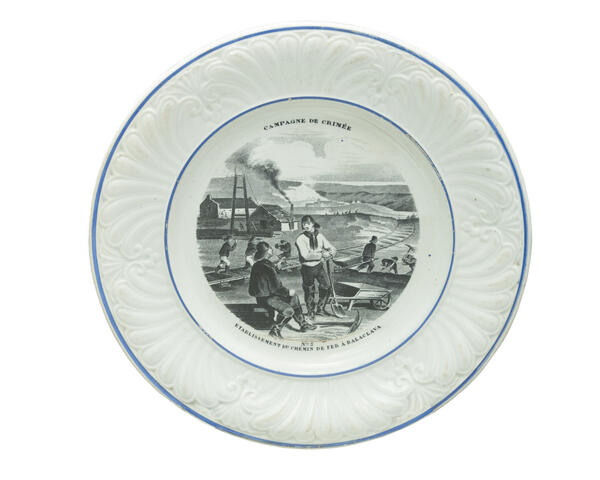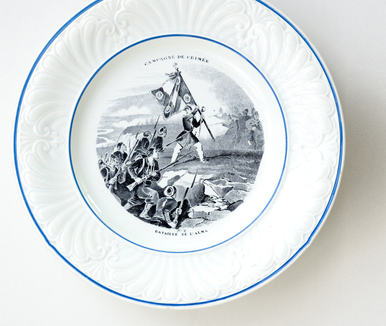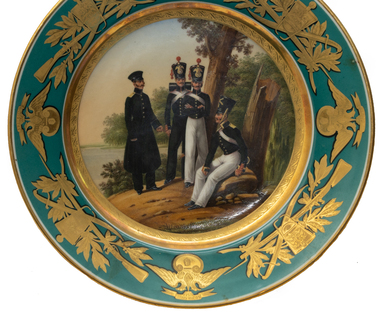During and after the Crimean War of 1853-1856, many souvenirs were produced in different countries. Mugs, bottles, plates and jars were made at the plants and factories. They depicted portraits of military leaders, pictures of important battles and events, as well as views of the cities in which they took place.
The white souvenir plate was made in the 1860s in France. In 2010, a private collector from Sevastopol, Rodion Zaichikov, donated it to the museum.
The classic round plate was covered with white glaze on top, an embossed vegetal ornament was applied to the outer edge, and the edges were framed with a thin blue stripe.
At the bottom of the plate there is a black and white image. In the foreground, two construction workers are talking during a break. One of them is leaning on a shovel, the other is sitting on the stacked rail sleepers. Near them there is a pickaxe, and a little way away, a wheelbarrow. Behind the worker’s backs, a rail track is in sight, where other construction workers arefixing sleepers to the rails. The background depicts a thin strip of the sea, a bay and mountains.
There are several French inscriptions on the plate. The text at the top —Campagne de Crimee — translates as “Crimean Campaign”. Below is the inscription №5 Etablissement du Chemin de fer a Balaclava — “№5 Construction of the railway in the Balaklava”. On the reverse side, on the tray of the plate, there is the “Creil et Montereau” trade mark. This was the name of the French company, which produced faience products.
The Balaklava railway, 12.8 kilometers long, was built by the British in February — March 1855. The construction was carried out by a private British firm “Peto, Brassay and Company”.
This railway was the first in the Crimea. It connected the Balaklava Bay and the military depot near Sapun Mountain, and delivered guns and shells to the siege-works sites.
In January 1855, the first batch of workers arrived in Balaklava from England with chief engineer James Batty. From there, 1,800 tons of rails, 6,000 rail sleepers, 300 tons of boards and about 2,000 tons of other cargo were delivered: cranes, platform cars, trolleys and pile driving machines. The construction was completed in seven weeks, by March 26, 1855.
To speed up the transportation of goods, steam locomotives were also delivered from Great Britain: “Commonwealth”, “Victory”, “Swan” and “Black Diamond.” After the war, the British dismantled the railway and sold it to Turkey.
The white souvenir plate was made in the 1860s in France. In 2010, a private collector from Sevastopol, Rodion Zaichikov, donated it to the museum.
The classic round plate was covered with white glaze on top, an embossed vegetal ornament was applied to the outer edge, and the edges were framed with a thin blue stripe.
At the bottom of the plate there is a black and white image. In the foreground, two construction workers are talking during a break. One of them is leaning on a shovel, the other is sitting on the stacked rail sleepers. Near them there is a pickaxe, and a little way away, a wheelbarrow. Behind the worker’s backs, a rail track is in sight, where other construction workers arefixing sleepers to the rails. The background depicts a thin strip of the sea, a bay and mountains.
There are several French inscriptions on the plate. The text at the top —Campagne de Crimee — translates as “Crimean Campaign”. Below is the inscription №5 Etablissement du Chemin de fer a Balaclava — “№5 Construction of the railway in the Balaklava”. On the reverse side, on the tray of the plate, there is the “Creil et Montereau” trade mark. This was the name of the French company, which produced faience products.
The Balaklava railway, 12.8 kilometers long, was built by the British in February — March 1855. The construction was carried out by a private British firm “Peto, Brassay and Company”.
This railway was the first in the Crimea. It connected the Balaklava Bay and the military depot near Sapun Mountain, and delivered guns and shells to the siege-works sites.
In January 1855, the first batch of workers arrived in Balaklava from England with chief engineer James Batty. From there, 1,800 tons of rails, 6,000 rail sleepers, 300 tons of boards and about 2,000 tons of other cargo were delivered: cranes, platform cars, trolleys and pile driving machines. The construction was completed in seven weeks, by March 26, 1855.
To speed up the transportation of goods, steam locomotives were also delivered from Great Britain: “Commonwealth”, “Victory”, “Swan” and “Black Diamond.” After the war, the British dismantled the railway and sold it to Turkey.



